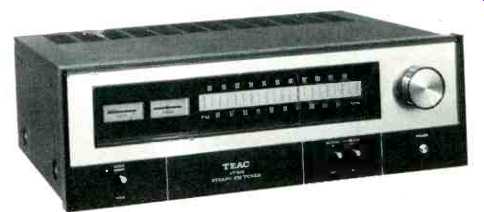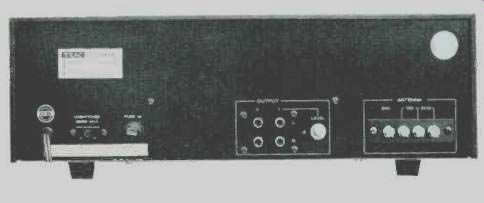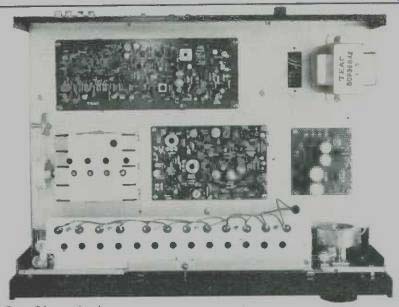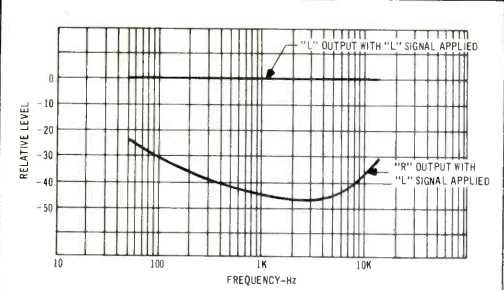
MANUFACTURER'S SPECIFICATIONS:
IHF Sensitivity: 2.0 uV.
S/N Ratio: Better than 70 dB.
THD (Mono): less than 0.5%.
Selectivity: Better than 65 dB.
Capture Ratio: below 1.5 dB.
Image Rejection: Better than 90 dB.
IF Rejection: Better than 90 dB.
AM Suppression: Better than 50 dB. 19 and 38 kHz suppression: better than 55 dB.
Frequency Response: 50-15,000 Hz t 1 dB.
Stereo FM separation: 1000 Hz: Better than 40 dB; 100-10,000 Hz: Better than 30 dB; 50-15,000 Hz: better than 20 dB.
Rated Output: Fixed: 1.0 V.; Variable: 1 .0 V.
Power Consumption: 16 watts at 117 V. AC.
Dimensions: 5-9/16" H. x 16-3/16" W. x 13" D.
Weight: 16 1/2 lbs.
Retail Price: $229.50.
In the course of testing and reviewing new components for AUDIO, we sometimes come across a product which surprises us, in terms of its previously unheralded performance. The TEAC AT-100 Stereo FM Tuner turned out to be such a product. Among its many virtues were an altogether outstanding signal-to-noise ratio, which measured an incredible 78 dB (a new record in tuner S/N measurements for us) and stereo separation of over 35 dB at 10 kHz.
The light gold and black front panel includes a large, long picture-framed dial-scale and meter area which occupies most of the top section of the front panel. A large, flywheel-coupled tuning knob is located to the right of this dial area. The dial scale itself is linear and, in addition to markings for every MHz from 88 to 108, there is a linear 0-100 logging scale.
This area, including the center-tune and signal strength meters, becomes illuminated in a soft blue color when power is applied to the unit. Along the bottom section of the panel are three slim-handled toggle switches. The left-most of these determines stereo or mono mode, and adjacent to the stereo setting is a tiny red-jeweled light which illuminates when a stereo station is tuned in. Towards the lower right are a pair of toggle switches which turn muting on and off and introduce a hi-blend circuit to reduce noise when weak-signal stereo stations are encountered. At the extreme lower right, directly under the tuning knob, is a power push-push button.
The rear panel (Fig. 1) contains an unswitched convenience AC outlet, a fuseholder and two pairs of output jacks. The first pair provides full-level outputs at all times while the second pair is controlled by a slotted level control so that output can be varied from zero to something over 1 volt r.m.s. to suit the needs of associated amplifying equipment.
Four screw terminals at the right of the rear panel accommodate 75-ohm or 300-ohm transmission lines from antenna as well as a system ground connection, if required.

Fig. 1--Rear panel view.

Fig. 2--Chassis layout.
Figure 2 discloses the uncluttered chassis layout. The sealed four-gang front end is manufactured by Alps, one of the better suppliers of high-quality FM-RF equipment in Japan.
Other well laid-out printed circuit modules include the i.f. muting board, a stereo multiplex decoder board and a separate power supply module. All of these modules are fully screened on their top surfaces with schematic part number designations so that a serviceman equipped with a schematic diagram would have no trouble locating a given component.
Unfortunately, the operating instruction manual does not include a schematic diagram, so our evaluation of the tuner is based strictly on performance. Visual observation disclosed that there are no integrated circuits used and semiconductor complement includes 25 transistors and 29 diodes altogether.
Performance Measurements
Major monophonic performance characteristics are plotted in Fig. 3. IHF sensitivity was measured as 1.8 microvolts, as opposed to the 2.0 microvolts claimed by Teac. More important, our new criterion of "microvolts required for 50 dB S/N" was a remarkably low 2.9 microvolts-about the best we have ever measured. At that very low signal input level, THD is already well under 1.0% for 100% modulation. At 10 microvolts of input signal, S/N had already reached 66 dB--a value that would have been quite respectable even at 1000 microvolts of signal strength. With increasing signal strength, residual noise just kept getting lower and lower until, at about 100 microvolts, the "ultimate" reading of 78 dB was obtained. Few broadcast stations in our area maintain this kind of S/N to begin with, so that it may be fairly stated that dynamic range of this fine tuner will be limited strictly by station practice and capability!

Fig. 3--Monophonic performance characteristics. Fig. 4--THD for both mono and
stereo.

Fig. 5--FM separation with "left-only" signal.
From about 30 microvolts and above, THD in mono (at 1000 Hz, 100% modulation) was a low, low 0.3% (Teac only claims 0.5%) and, although our plot does not go beyond 1000 uV, signal levels of 50,000 uV and higher did not cause this low THD figure to rise, indicating a lack of front-end overload problems.
Figure 4 shows THD for both mono and stereo operation at all frequencies of interest. In monophonic operation, harmonic distortion never exceeds 0.8% throughout the audio range while for stereo, THD remains below 1.0% from 50 Hz to 7 kHz. The 2% reading shown at 10 kHz is the result of minute "beats" rather than actual harmonic distortion and, as such, is not to be taken as significantly as might be the case for actual THD. Figure 5 shows stereo FM separation when a "left-only" signal is applied. In making our measurements, both channels were checked but the results were so close to being identical that a dual plot was not deemed necessary. At 1000 Hz, separation was measured as 43.5 dB (against the 40 dB claimed) and at somewhat higher frequencies we actually measured separation of as high as 47 dB. Note that at 8 kHz, where most sets are considered to be doing well if they can maintain 30 dB of separation, the Teac AT-100 still exhibits 40 dB of separation. Separation at the extreme low end tends to fall off, however, reaching 30 dB at 100 Hz and decreasing to about 25 dB at the lower limit of 50 Hz.
As noted earlier, the Teac AT-100 is equipped with a "high-blend" switch. Activating this circuit causes cross blending of high-frequency noise from left to right outputs and vice versa. Since the noise output of a multiplex decoder circuit is basically out of phase from one channel to the other, the result is a partial cancellation of the increased noise normally noted when tuned to a weak stereo station signal.
The switch would normally not be used under reasonably strong signal conditions, but we did find that Teac has gone a bit too far in its choice of components for this cross-blend circuit. Although frequency response is not affected, separation suffers a bit too heavily when the switch is used, decreasing to 12 dB at 1000 Hz and even less at higher frequencies.
Other important measurements confirmed but not shown in curves include a measured capture ratio of 1.3 dB (a bit better than the 1.5 dB claimed), alternate channel selectivity of 68 dB (again, better than the 65 dB claimed), spurious response and image rejection in excess of 90 dB (as claimed) and IF rejection of at least 95 dB (better than claimed). Frequency response in mono was within 0.5 dB from 50 Hz to 15 kHz and within 1.0 dB over the same range for stereo. AM suppression was measured as 53 dB while audio output level for 100% modulation was 1.6 volts r.m.s.-somewhat higher than claimed.
Listening Tests
We have been using the TEAC AT-100 tuner for more than a week of listening and, concentrating on a few of the better stations in our area (the very few), have not been able to fault its performance in any way. There is no measurable drift and the center-tune indication of the tuning meter corresponds perfectly with actual center-of-channel tuning. One noteworthy effect we encountered is the relatively minor difference between the noise level of a stereo station in stereo versus the same station in mono mode. In most cases there was no difference, whereas in our location and with our particular antenna array we usually can detect a noticeable increase in background noise level when switching from mono to stereo. The very steep quieting characteristic is surely responsible for this welcome improvement. We logged some 48 usable stations, of which 25 were stereo broadcasting, and found it necessary to use the "high-blend" control for only three of the latter.
There are many costlier tuners on the market these days, some with digital read-outs, some with signal-seeking automatic tuning, some with oscilloscope displays and even programmable logic circuitry. These features will surely appeal to some users, but if you are looking for top FM and stereo FM performance with no extra frills and at relatively low cost, the TEAC AT-100 tuner is certainly worth considering.
--Leonard Feldman
=================
(Adapted from Audio magazine, Jun. 1973)
Also see:
Teac Model AS-200U Amplifier (Equip. Profile, Apr. 1970)
TEAC Model AS-100 Integrated Amplifier (Equip. Profile, Jan. 1973)
= = = =